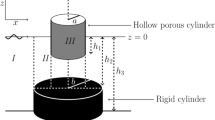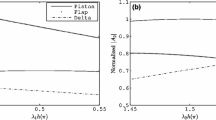Abstract
Employing the methods of separation of variables and matched eigenfunction expansions for velocity potential, analytical solutions are proposed for a water wave radiation problem of a floating semi-porous compound cylinder in finite ocean depth. The configuration of the semi-porous compound cylinder is such that it consists of an impermeable inner cylinder rising above the free surface and a coaxial truncated porous cylinder around the lower part of the inner cylinder with the top of the porous cylinder being impermeable. The condition on the porous boundary is defined by applying Darcy’s law as in Williams et al. (Ocean Eng 27:1–28, 2000) . The translational motions in the x- and z-directions, i.e., surge and heave motions, are investigated. A mathematical model is developed which can be considered as an extension of a number of the earlier works, e.g., Kokkinowrachos et al. (Ocean Eng 13:505–538, 1986) and Calisal and Subancu (Ocean Eng 11(5):529–542, 1984), in which significance of porosity of the structure was neglected. Numerical investigation is taken up here in order to examine the influence of submerged depth, radii, porous coefficient, and water depth on added mass and radiation damping, two most important entities in radiation problems, with respect to surge and heave motions. It is found that the variation of porous coefficient, radii, and depth has a significant influence on the added mass and damping coefficients for the semi-porous compound cylinder. The added mass is found not sufficiently affected by lower values of porous coefficient G, but exhibits significant variation corresponding to higher values of G. Another important observation is that the damping coefficients oscillate alternately between negative and positive values which can be attributed to coupled behavior between different motions. The results establish that an appropriate optimal ratio of various parameters may be considered in designing ocean structures with minimum adverse hydrodynamic effect. The effectiveness of the present model is validated by comparing it with an available result which shows an excellent agreement.

















Similar content being viewed by others
References
D.D. Bhatta, M. Rahman, On the scattering and radiation problem for a cylinder in water of finite depth. Int. J. Eng. Sci. 41, 931–967 (2003)
D.D. Bhatta, Computation of added mass and damping coefficients due to a heaving cylinder. J. Appl. Math. Comput. 23(1–2), 127–140 (2007)
J.L. Black, C.C. Mei, C.G. Bray, Radiation and scattering of water waves by rigid bodies. J. Fluid Mech. 46(1), 151–164 (1971)
L. Berggren, M. Johansson, Hydrodynamic coefficients of a wave energy device consisting of a buoy and a submerged plate. Appl. Ocean Res. 14, 51–58 (1992)
S.M. Calisal, T. Sabuncu, Hydrodynamic coefficients for vertical composite cylinders. Ocean Eng. 11(5), 529–542 (1984)
P.G. Chamberlain, D. Porter, On the solution of the dispersion relation for water waves. Appl. Ocean Res. 21, 161–166 (1999)
A.T. Chwang, A porous wavemaker theory. J. Fluid Mech. 132, 395–406 (1983)
M.K.D. Darwiche, A.N. Williams, K.H. Wang, Wave interaction with a semi-porous cylindrical breakwater. J. Waterw. Port Coast. Ocean Eng. 120, 382–403 (1994)
S. Das, S.N. Bora, Reflection of oblique ocean water waves by a vertical rectangular porous structure placed on an elevated horizontal bottom. Ocean Eng. 82, 135–143 (2014)
S. Das, S.N. Bora, Damping of oblique ocean waves by a vertical porous structure placed on a multi-step bottom. J. Mar. Sci. Appl. 13, 362–376 (2014)
Internet site. https://en.wikipedia.org/wiki/Schwinger-variational-principle
Internet site. https://www.offshorewind.biz/category/in-depth/
S.C. Jiang, Y. Gou, B. Teng, Water wave radiation problem by a submerged cylinder. J. Eng. Mech. 140, 06014003 (2013)
K. Kokkinowrachos, S. Mavrakos, S. Asorakos, Behaviour of vertical bodies of revolution in waves. Ocean Eng. 13, 505–538 (1986)
S.R. Manam, M. Sivanesan, Scattering of water waves by vertical porous barriers: an analytical approach. Wave Motion 67, 89–101 (2016)
S. Mandal, N. Datta, T. Sahoo, Hydroelastic analysis of surface wave interaction with concentric porous and flexible cylinder systems. J. Fluids Struct. 42, 437–455 (2013)
P. McIver, D.V. Evans, The occurrence of negative added mass in free-surface problems involving submerged oscillating bodies. J. Eng. Math. 18, 7–12 (1984)
M.S. Park, W. Koo, Y. Choi, Hydrodynamic interaction with an array of porous circular cylinders. Int. J. Nav. Arch. Ocean Eng. 2, 146–154 (2010)
M.S. Park, W. Koo, Mathematical modeling of partial-porous circular cylinders with water waves, Mathematical Prob. Eng., Paper ID 903748, p. 19 (2015)
T. Sahoo, A.T. Chan, A.T. Chwang, Scattering of oblique surface waves by permeable barriers. J. Waterw. Port Coast. Ocean Eng. 126, 196–205 (2000)
K. Sankarbabu, S.A. Sannasiraj, V. Sundar, Interaction of regular waves with a group of dual porous circular cylinders. Appl. Ocean Res. 29, 180–190 (2007)
A. Sarkar, S.N. Bora, Hydrodynamic forces due to water wave interaction with a bottom-mounted surface-piercing compound porous cylinder. Ocean Eng. 171, 59–70 (2019)
A. Sarkar, S.N. Bora, Water wave diffraction by a surface-piercing floating compound porous cylinder in finite depth. Geophys. Astro. Fluid 113(4), 348–376 (2019)
A. Sarkar, S.N. Bora, Hydrodynamic forces and moments due to interaction of linear water waves with truncated partial-porous cylinders in finite depth. J. Fluid Struct., 94, Paper ID 102898 p. 29 (2020)
C. K. Sollitt, R. H. Cross, Wave transmission through permeable breakwaters. in Proceedings 13th Conference Coastal Engineering, Vancouver (1972)
G.I. Taylor, Fluid flow in regions bounded by porous surfaces. Proc. R. Soc. Lond. A 234, 456–475 (1956)
A.N. Williams, A.G. Abul-Azm, Hydrodynamic interactions in floating cylinder arrays-II. Wave Radiat. Ocean Eng. 16(3), 217–263 (1989)
A.N. Williams, W. Li, The hydrodynamics of floating compound cylinders. J. Off. Mecha. Arctic Eng. 121, 213–218 (1999)
A.N. Williams, W. Li, Water wave interaction with an array of bottom-mounted surface-piercing porous cylinders. Ocean Eng. 27, 841–866 (2000)
A.N. Williams, W. Li, K.-H. Wang, Water wave interaction with a floating porous cylinder. Ocean Eng. 27, 1–28 (2000)
B.J. Wu, Y.H. Zheng, Y.G. You, D.S. Jiea, Y. Chen, On diffraction and radiation problem for two cylinders in water of finite depth. Ocean Eng. 33, 679–704 (2006)
H. Yu, S. Zheng, Y. Zhang, G. Iglesias, Wave radiation from a truncated cylinder of arbitrary cross section. Ocean Eng. 173, 519–530 (2019)
R.W. Yeung, Added mass and damping of a vertical cylinder in finite-depth waters. Appl. Ocean Res. 3(3), 119–133 (1981)
R.W. Yeung, L. Wang, Radiation and exciting forces of axisymmetric structures with a moonpool in waves. J. Mar. Sci. Appl. 17(3), 297–311 (2018)
X.P. Yu, Diffraction of water waves by porous breakwaters. J. Waterw. Port Coast. Ocean Eng. 121, 275–282 (1995)
F. Zhao, W. Bao, T. Kinoshita, H. Itakura, Interaction of waves and a porous cylinder with an inner horizontal porous plate. App. Ocean Res. 32, 252–259 (2010)
F. Zhao, W. Bao, T. Kinoshita, H. Itakura, Theoretical and experimental study on a porous cylinder floating in waves. J. Off. Mecha. and Arctic Eng., 133 (1), Paper ID 011301 (2011)
F. Zhao, T. Kinoshita, W. Bao, L. Huang, Z. Liang, R. Wan, Interaction between waves and an array of floating porous circular cylinders. China Ocean Eng. 26(3), 397–412 (2012)
Y.H. Zheng, Y.M. Shen, Y.G. You, B.J. Wu, L. Rong, Hydrodynamic properties of two vertical truncated cylinders in waves. Ocean Eng. 32, 241–271 (2005)
S. Zheng, Y. Zhang, Wave radiation from a truncated cylinder in front of a vertical wall. Ocean Eng. 111, 602–614 (2016)
Acknowledgements
Both authors are immensely grateful to the two anonymous esteemed reviewers for their insightful comments which helped in carrying out a suitable revision, and to the Editor-in-Chief Professor Toru Sato for allowing a revision. The first author expresses his gratefulness to Indian Institute of Technology Guwahati, India for providing him a senior research fellowship to pursue PhD.
Author information
Authors and Affiliations
Corresponding author
Additional information
Publisher's Note
Springer Nature remains neutral with regard to jurisdictional claims in published maps and institutional affiliations.
Appendix: Porous coefficient G
Appendix: Porous coefficient G
The dimensionless porous parameter G can be defined as \(\displaystyle G=\displaystyle \frac{L \rho \sigma }{\varepsilon k_0}\), as was used by Chwang [7]. In general, being complex, it can be expressed as \({G_r +\mathrm{i} G_i}\) (Yu [35]), where \(G_r\) and \({G_i}\), respectively, denote the real and the imaginary parts. In practice, G always possesses positive real and imaginary parts except when the resistance effect against the flow dominates the inertial effect of the fluid inside the porous material in which case G becomes real. Similarly, when the inertial effect dominates the resistance effect, G becomes purely imaginary. The parameter G may be viewed as a Reynolds number for the flow passing through the fine pores of the wall (Chwang [7]). It is also a measure of the porous effect of the wall. \({G = 0}\) implies that the porous wall is impermeable. On the other hand, as G approaches infinity, the porous wall is completely permeable to fluid, that is, there would be no porous wall at all. Basically here we work with Darcy’s law, which is applicable for low Reynolds number flow through porous wall. Also Sankarbabu et al. [21] proposed to choose G as
with h as the draft of the structure.
Initially, the value of G for a given porosity is obtained by trial and error method. On substitution of the obtained G and other known values in the above expression, the unknown material constant (L) for the given porosity of the outer cylinder is calculated. Based on linear extrapolation, the material constant values for other porosities are computed resulting in values of G.
Conforming to the assumptions and conditions used in this work, G is taken to be real since the flow dominates the inertial effect of the fluid inside the porous cylinder.
Rights and permissions
About this article
Cite this article
Sarkar, A., Bora, S.N. Hydrodynamic coefficients for a floating semi-porous compound cylinder in finite ocean depth. Mar Syst Ocean Technol 15, 270–285 (2020). https://doi.org/10.1007/s40868-020-00086-0
Received:
Accepted:
Published:
Issue Date:
DOI: https://doi.org/10.1007/s40868-020-00086-0




